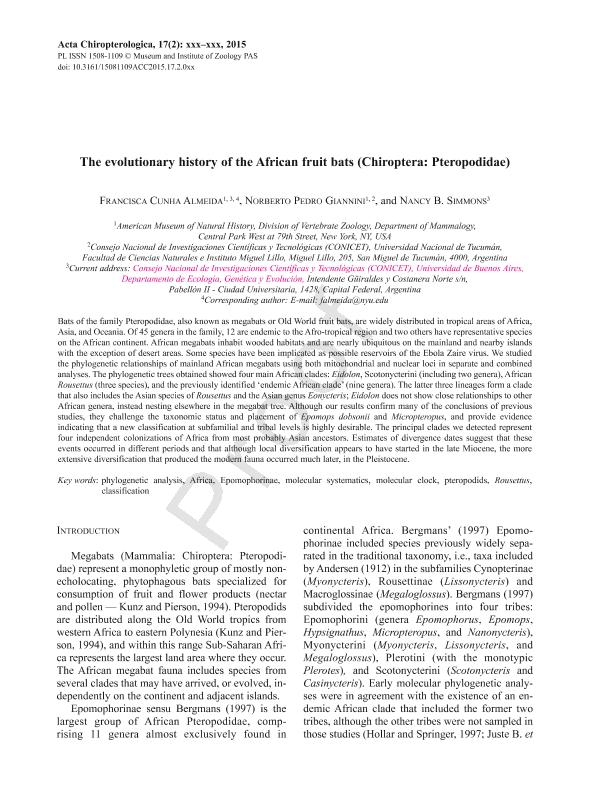Mostrar el registro sencillo del ítem
dc.contributor.author
Cunha Almeida, Francisca

dc.contributor.author
Giannini, Norberto Pedro

dc.contributor.author
Simmons, Nancy B.
dc.date.available
2017-02-10T17:32:55Z
dc.date.issued
2015-12
dc.identifier.citation
Cunha Almeida, Francisca; Giannini, Norberto Pedro; Simmons, Nancy B.; The evolutionary history of the African fruit bats (Chiroptera: Pteropodidae); Polish Academy Of Sciences; Acta Chiropterologica; 18; 1; 12-2015; 73-90
dc.identifier.issn
1508-1109
dc.identifier.uri
http://hdl.handle.net/11336/12847
dc.description.abstract
Bats of the family Pteropodidae, also known as megabats or Old World fruit bats, are widely distributed in tropical areas of Africa, Asia, and Oceania. Of 45 genera in the family, 12 are endemic to the Afro-tropical region and two others have representative species on the African continent. African megabats inhabit wooded habitats and are nearly ubiquitous on the mainland and nearby islands with the exception of desert areas. Some species have been implicated as possible reservoirs of the Ebola Zaire virus. We studied the phylogenetic relationships of mainland African megabats using both mitochondrial and nuclear loci in separate and combined analyses. The phylogenetic trees obtained showed four main African clades: Eidolon, Scotonycterini (including two genera), African Rousettus (three species), and the previously identified ‘endemic African clade’ (nine genera). The latter three lineages form a clade that also includes the Asian species of Rousettus and the Asian genus Eonycteris; Eidolon does not show close relationships to other African genera, instead nesting elsewhere in the megabat tree. Although our results confirm many of the conclusions of previous studies, they challenge the taxonomic status and placement of Epomops dobsonii and Micropteropus, and provide evidence indicating that a new classification at subfamilial and tribal levels is highly desirable. The principal clades we detected represent four independent colonizations of Africa from most probably Asian ancestors. Estimates of divergence dates suggest that these events occurred in different periods and that although local diversification appears to have started in the late Miocene, the more extensive diversification that produced the modern fauna occurred much later, in the Pleistocene.
dc.format
application/pdf
dc.language.iso
eng
dc.publisher
Polish Academy Of Sciences

dc.rights
info:eu-repo/semantics/openAccess
dc.rights.uri
https://creativecommons.org/licenses/by-nc-sa/2.5/ar/
dc.subject
Phylogenetic Analysis
dc.subject
Africa
dc.subject
Epomophorinae
dc.subject
Molecular Systematics
dc.subject
Molecular Clock
dc.subject
Pteropodids
dc.subject
Rousettus
dc.subject
Classification
dc.subject.classification
Zoología, Ornitología, Entomología, Etología

dc.subject.classification
Ciencias Biológicas

dc.subject.classification
CIENCIAS NATURALES Y EXACTAS

dc.title
The evolutionary history of the African fruit bats (Chiroptera: Pteropodidae)
dc.type
info:eu-repo/semantics/article
dc.type
info:ar-repo/semantics/artículo
dc.type
info:eu-repo/semantics/publishedVersion
dc.date.updated
2017-02-09T18:24:23Z
dc.identifier.eissn
1733-5329
dc.journal.volume
18
dc.journal.number
1
dc.journal.pagination
73-90
dc.journal.pais
Polonia

dc.journal.ciudad
Varsovia
dc.description.fil
Fil: Cunha Almeida, Francisca. American Museum Of Natural History; Estados Unidos. Universidad de Buenos Aires. Facultad de Ciencias Exactas y Naturales. Departamento de Ecología, Genética y Evolución; Argentina
dc.description.fil
Fil: Giannini, Norberto Pedro. American Museum Of Natural History; Estados Unidos. Universidad Nacional de Tucumán. Facultad de Ciencias Naturales e Instituto Miguel Lillo; Argentina. Consejo Nacional de Investigaciones Científico y Técnicas. Centro Científico Tecnológico Tucumán. Unidad Ejecutora Lillo; Argentina
dc.description.fil
Fil: Simmons, Nancy B.. American Museum Of Natural History; Estados Unidos
dc.journal.title
Acta Chiropterologica

dc.relation.alternativeid
info:eu-repo/semantics/altIdentifier/doi/http://dx.doi.org/10.3161/15081109ACC2016.18.1.003
dc.relation.alternativeid
info:eu-repo/semantics/altIdentifier/url/http://www.bioone.org/doi/abs/10.3161/15081109ACC2016.18.1.003
Archivos asociados
